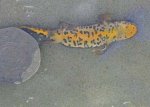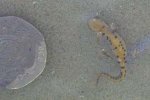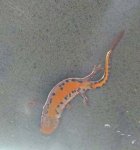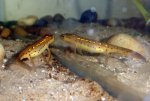Niels D
Well-known member
- Joined
- Jun 2, 2011
- Messages
- 1,335
- Reaction score
- 112
- Points
- 63
- Location
- A little village called Terheijden
- Country
- Netherlands
My gf wanted to raise our noto lavae in a terrestrial setup. I wanted to keep them aquatic. We each made our own setup and we put 2 in an terrestrial setup and 1 in an aquatic one. We had more larvae this year, but they were lost due to an accident that happened when we were on vacation, but that's another story.
All three of the larvae are eating. The terrestrial ones are on a diet of tiny crickets, fruit flies and collembola. The other one's offered daphnia, tubifex and bloodworms. When they got seperated they had the same size. The seperation took place only 2 weeks ago. Now look at the difference:

I knew it would make a difference and that the aquatic one would grow faster, but I never expected such a result in just 2 weeks.
Sorry for the fact I don't know if I had to call them larvae of efts.
All three of the larvae are eating. The terrestrial ones are on a diet of tiny crickets, fruit flies and collembola. The other one's offered daphnia, tubifex and bloodworms. When they got seperated they had the same size. The seperation took place only 2 weeks ago. Now look at the difference:

I knew it would make a difference and that the aquatic one would grow faster, but I never expected such a result in just 2 weeks.
Sorry for the fact I don't know if I had to call them larvae of efts.
Last edited:








